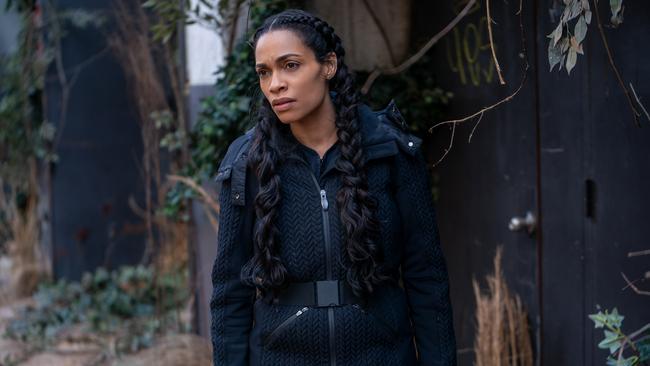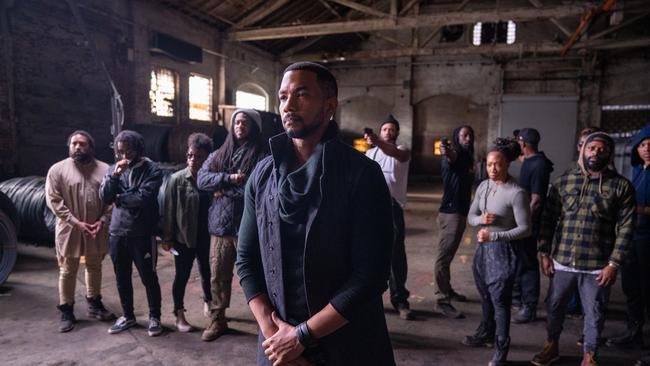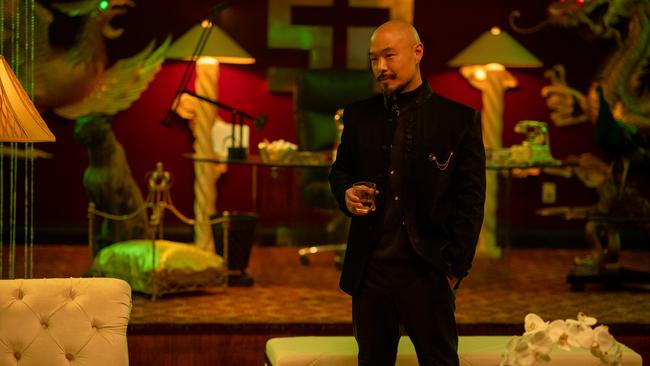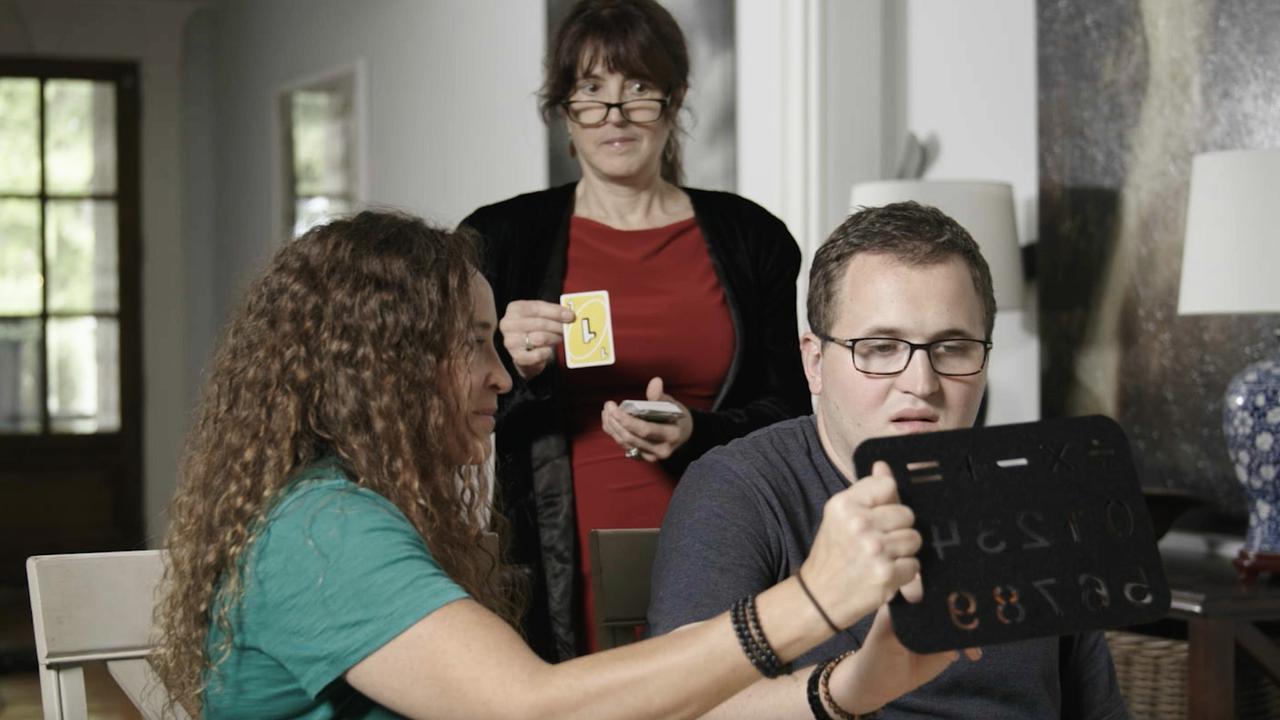DMZ, TV series based on DC comic, worth price of admission
In a controversial new HBO series, Manhattan is at the centre of a civil war between the US government and the secession-bent Free States of America.

I just managed to catch up with the somewhat controversial HBO TV series DMZ, which has endured a rollercoaster critical ride since it went to air a few weeks ago. While the dystopian drama is perhaps more impressive for its intentions than achievements, it’s certainly a fabulous cinematic, often intoxicating ride.
It comes from several highly credentialed filmmakers in Roberto Patino, who created and writes the series, and Ava DuVernay, who is executive producer and director of the first style-setting episode. Oscar-nominated DuVernay (Selma, When They See Us) specialises in sharing untold stories from the American experience in what she calls “a worldwide, huge way”, and Patino is also drawn to dark, complex material; his credits include Sons of Anarchy, The Bastard Executioner, and Westworld. (He says: “In truth, what I really like is finding humanity in characters, most of all, and especially when that’s a challenge.”)
The series features some classy acting power too in Rosario Dawson, most recently joining the Star Wars universe as Ahsoka Tano in The Mandalorian; Benjamin Bratt, best known as Detective Reynaldo Curtis on the long-running Law and Order; and Hoon Lee, one of the stars of Jonathan Tropper’s wonderfully lurid martial arts drama Warrior.
The four-part dystopian thriller is adapted from the cult DC comic book series of the same title, a dystopian alternate universe narrative created in 2005 by writer and graphic designer Brian Wood and stylishly drawn by Italian artist Riccardo Burchielli.
A beleaguered Manhattan is at the centre of a civil war between the US government, run by a corrupt and brutal dictatorship in Washington, and the secession-bent Free States of America, a grassroots insurrection from the heartland.
Manhattan is the DMZ, the demilitarised zone between the two warring factions determined to rule the country, its 400,000 inhabitants battling to stay alive in what Wood described as “equal parts Escape from New York, Fallujah, and New Orleans right after Hurricane Katrina”. The series started in January 2006 and completed on February 2012 after 72 issues, and grabbled with worrying issues like military occupation, terrorism and corporate corruption. As the writer Alec Bojalad suggested: “It was a way to present to the Western world that their worst case post-apocalyptic scenario was someone else’s unavoidable present.”
Part of the discontent in the US circling around the series possibly relates to the fact that originally it was planned as a lavishly financed ongoing show for HBO, given the almost countless storylines in the original comics.
But, as reported by Polygon.com, the production seems to have suffered more than many because of Covid’s disruptions and deprivations and the series halted production in March 2020 after filming the pilot, resuming in late 2021 as a four-episode miniseries. What might have been a more epic production became a much smaller, personal story according to Patino, cut down to a rather crammed four episodes, but like the comic on which it’s based it happens to be tragically prescient.
“The script for the first episode was an explanation of a much larger bible of what was going to be an ongoing series,” Bratt told a press conference after the first screening.
“And it was only after the pilot was put together, with the limitations that came about as a result of the pandemic, that we learned that it was going to be sized considerably downwards into a four-part miniseries.”
According to Dawson at the same event, this drastic change meant that a lot of fat was trimmed for the story, and rather than explore the macro implications of the DMZ, the more concentrated story helped the actors home in on the journey their characters needed.
“We had a lot of time to deliberate on the story and these characters,” Dawson said. “The pivots in the story come quite quickly because all that space was crunched into these four episodes. And so every single beat is intense.
“Sometimes you can watch a show and there are those filler episodes. There’s no filler moments in this entire thing.”
The comic version of DMZ followed the adventures of journalist Matty Roth as he chronicled the volatile and deadly politics of a war-torn New York, linking the many stories as he somehow navigated his way around the warring factions.
But in a major departure, Patino places Dawson’s Alma Ortega, a relatively minor figure in the original stories, at the centre of a new plot line, a feisty Latino nurse working in an intake facility, crowded with people detained for unlawful entry into the US. It’s a country with strict boundaries and demarcations. “The border keeps shifting every day,” she tells a refugee.
Her real objective, though, is to find her son, Christian, the teenager she lost during an air attack at the start of the conflict eight years earlier.
With the help of a colleague she emerges from the facility through a kind of portal into a fantasy war zone setting, lush plants growing out of buildings, the top of the Chrysler Building upside-down, burnt out cars lining the streets of Manhattan, even the occasional escaped jaguar prowling for food.

This is the DMZ, a no-man’s land abandoned by both governments, those who could evacuate having fled and those who could not being forced to fend for themselves. It’s what Patino calls, “a pretty fractured and forgotten world”. But as Alma discovers, its abandoned people are determined to reclaim their sense of community and identity. It’s easy to see that cinematographer Matthew J. Lloyd and production designer Scott Dougan obviously enjoyed creating a vibrant emerging new city and there’s a brilliant blood-pumping score from Emmy-winner Kris Bowers.
Alma is told she has only 24 hours to find Christian, otherwise she’ll lose her secret route out of the DMZ, and the clock ticks through the first episode, though she seems hardly too concerned. She even finds a moment to help out at a medical clinic tending to a victim with terrible gunshot wounds. Meanwhile, in Central Park, a thriving sense of community prevails. It is a place alive with colour and pulsating music.
We meet gang boss Parco Delgado, played by a lean, charmingly menacing black-clad Benjamin Bratt, addressing followers from all over New York organised into loose collectives. He’s running for governor of the DMZ. “They call this the DMZ but this ain’t neutral territory,” he tells them. “This is abandonment, they want us in so they can turn their backs on us; our own people did this to us, to you. We keep this unity going folks we will be our own state.” There’s a coiled intensity about this leader of the Upper West Side-controlling Harlem Kings, intense eyes that could stop a bullet in its tracks.
But there’s a rival gang, led by the ostentatious Chinatown boss Wilson Lin, played with authority by Hoon Lee, who surrounds himself with a squad of scantily dressed female bodyguards.
By some stretch of the imagination it turns out Alma has a questionable history with both men, Parco an old lover, Lin an early fling, that starts to set the story alive.
In a serendipitous moment after she discovers fateful news about her son she scrawls in bold white text with a large paint roller over a very public hit list left by the Harlem Kings on a building site “EYES FORWARD LOVE”.
Yes I know it sounds preposterous, but Patino and DuVernay manage to make sense of it all, even if the storylines start to get pinched and somewhat squashed by Patino’s effort to pull a complex narrative together and take it into the final three episodes.

Alma’s gesture represents hope for a group of minorities battling for their place in a country that disdains them. And there’s little doubt she is already the human face of the terrible civil war, and more than anyone else will represent optimism in this divisive war zone.
“We really wanted to present the DMZ as a place where life finds a way and where people of disparate walks of life are coming together,” Patino says. “That’s why we just assume the war. We don’t really dwell on how or why we got there.
“We assume it and we start eight years later in it, and then we tell a story of what happens next, which is the dawn of a new civilisation.”
It’s certainly an ambitious piece of TV, even if a little confusing at times, and DuVernay’s direction is intelligent, witty and imaginative, and in her clever use of the extreme close-up effect set against abstracted colourful backgrounds, highly cinematic.
It’s beautifully watchable with a super-saturated visual vernacular all of its own.
DMZ streaming on Foxtel On Demand.



